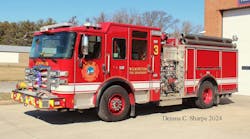Apr. 1—In 2022, firefighters aboard one of the Seattle Fire Department's ladder trucks noticed something felt funny in the vehicle's articulation. When maintenance crews took a closer look, they saw the fifth wheel bearing — a tree-trunk-sized metal disc that allows the long trucks to bend in half around tight city curves — had not been greased in some time. The resulting damage was significant enough that the truck would have to be sidelined in the city's maintenance facility for extensive and expensive repairs.
Regular preventive maintenance like greasing a bearing is one of many tasks a city mechanic would carry out when a ladder truck comes in, but in recent years, such routine inspections have lagged. Staff shortages, supply chain backlogs, increased call volumes, a budget squeeze and an aging fleet all mean the city's ability to be proactive about its fire equipment is hobbled.
As a result, the Seattle Fire Department has seen a more than 50% increase since 2016 in vehicles being pulled from service due to breakdowns or malfunctions. It has complicated the logistics and lengthened the timelines of emergency response. Vehicles typically reserved for training exercises are substituted in and trucks due for preventive work go without, creating a sort of negative feedback loop.
"I hate to use the term perfect storm, but it's kind of like that," said Chris Wiley, the city of Seattle's fleet director.
Vehicles breaking down means new rigs have to be swapped, an hourslong process that entails moving equipment, driving between stations and dropping off the broken truck.
"In that respect, it does impact our ability to respond," said Chris Lombard, assistant chief with the Seattle Fire Department.
Officials with the city's finance department have been raising the alarm about the state of the Fire Department's fleet since at least 2022. The department's former director, Calvin Goings, pushed the city's budget office for money to hire more mechanics, according to records received through a public disclosure request, but was rebuffed amid a looming — and still unresolved — budget crisis.
"Unfortunately, failures like this will continue until the Fire Garage can get in front of the preventative maintenance intervals," he wrote to Seattle Fire Department staff at the time.
Last year, 80% of the work done on Seattle Fire Department vehicles was repairs, while just 20% was preventive maintenance. That's well off the city's goal of 40% repairs and 60% maintenance.
The gold standard of preventive maintenance is once every six months; last year, just half of the Fire Department's fire engines and 18% of its ladder trucks received one checkup in 2023.
That lagging maintenance is a particular problem because the Fire Department's fleet is creeping beyond the industry's standard life span of 12 to 15 years old. Currently, 41% of ladder trucks and 45% of fire engines are older than 15 years.
Backlogs in deliveries for new trucks mean many of those will go to 20 years and beyond.
It used to take a year to replace a truck. Now, said Lombard, it's 54 months for a ladder truck — 4.5 years. Like the ferry system, the result is crews finding ways to stretch the life span of what they currently have.
"To keep them safe is just going to take a lot more effort," said Lombard.
Seattle's hills and potholes do a number on transmissions and suspension, so it's a hard 20 years.
At the same time, call volume is up more than 20% since 2019.
"Our equipment is worn out a lot faster, because we do a lot more runs," said Lisa Reager, deputy division director of fleet operations. "So our engine hours are higher than our miles generally and we have different conditions than a lot of cities do and that's a big deal."
When the city's cars and trucks need repairs, most go to the maintenance yard near the Chinatown International District. The sprawling facility takes up nearly four city blocks and is packed with police cruisers, utility trucks, parking enforcement caddies and rarely used emergency response vehicles, including a truck with a massive fan mounted on the back, purchased in case of a fire in a downtown tunnel.
Wiley, who has overseen the city's fleets division for the last 10 years, said he lacks the staff to keep up with the hours all those vehicles need.
Fire Department vehicles occupy a disproportionate number of worker hours. Though they make up around 6% of the city's fleet, about a quarter of his employees are assigned to work on the engines, aid cars and ladder trucks.
The reason is simple: They're incredibly complex vehicles. A successful fire mechanic must understand hydraulics, electrical communication equipment and hydromechanics, in addition to diesel engines.
"Your standard diesel mechanic is working on just this stuff," Wiley said on the floor of the shop, gesturing to an exposed engine, "working on brakes, wheels, making sure the engine runs properly. But fire mechanics then have to learn also about how to fix the pumps and all the other control technologies."
In recent years, his fleet has seen about 50% turnover, most of whom leave for better-paying jobs, particularly with the Port of Seattle.
Wiley estimates it takes a fully capable diesel mechanic three to four years to come up to speed on fire equipment. The pipeline of people interested in the jobs used to be strong enough that replacing someone wasn't a problem, but interest is down significantly, as it is for many trade jobs.
The City Council is considering a new worker contract that would see significant raises for mechanics — up to 38% — and Wiley hopes that will help with both recruitment and retention.
But even if he could find workers, Wiley said they don't have the budget to hire enough of them. In 2022, the finance department asked the city budget office to approve three additional positions, to no luck as the city looks ahead to a likely $250 million budget deficit next year.
"Increasing the size of our staff is the only way we can assure SFD's apparatus are being maintained at the highest standards to ensure the safety of the crews and public," Goings wrote at the time. "However, this request was denied by [the city budget office]."
A spokesperson for Mayor Bruce Harrell, Callie Craighead, said the mayor approved four hires to fill vacancies in the fleets division, despite the citywide hiring freeze currently in place. The city has taken to preordering parts before they're needed to get around supply chain issues clogging certain repairs, Craighead said.
"As we work to develop a sustainable budget that maintains essential services, we will continue to thoughtfully consider all factors including the maintenance needs of our city fleets," Craighead said.
___
(c)2024 The Seattle Times
Visit The Seattle Times at www.seattletimes.com
Distributed by Tribune Content Agency, LLC.






